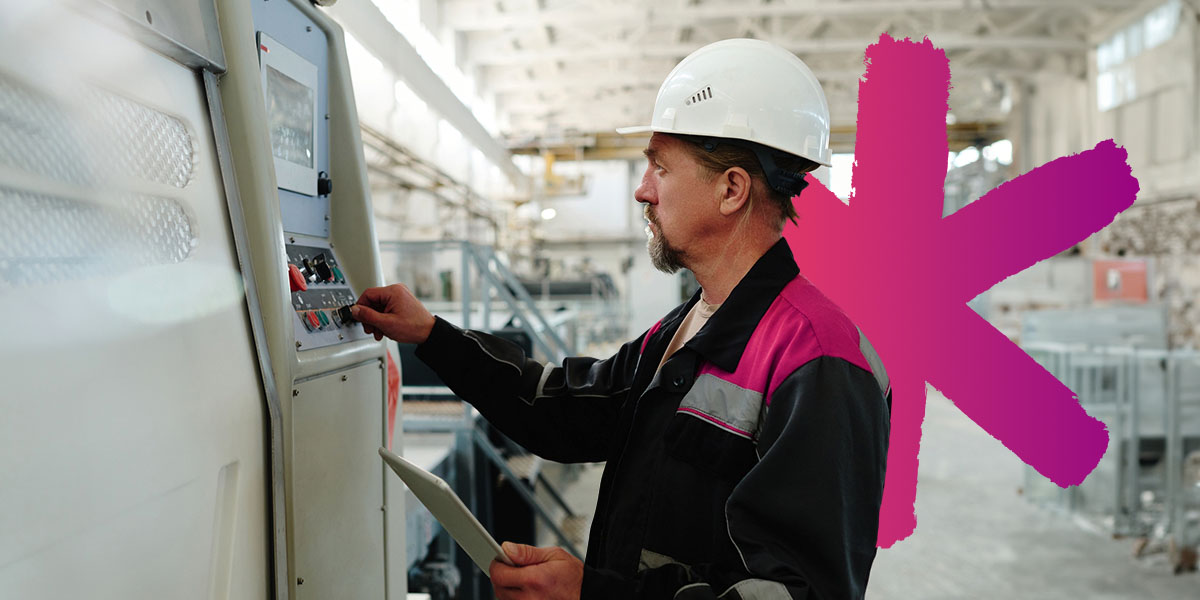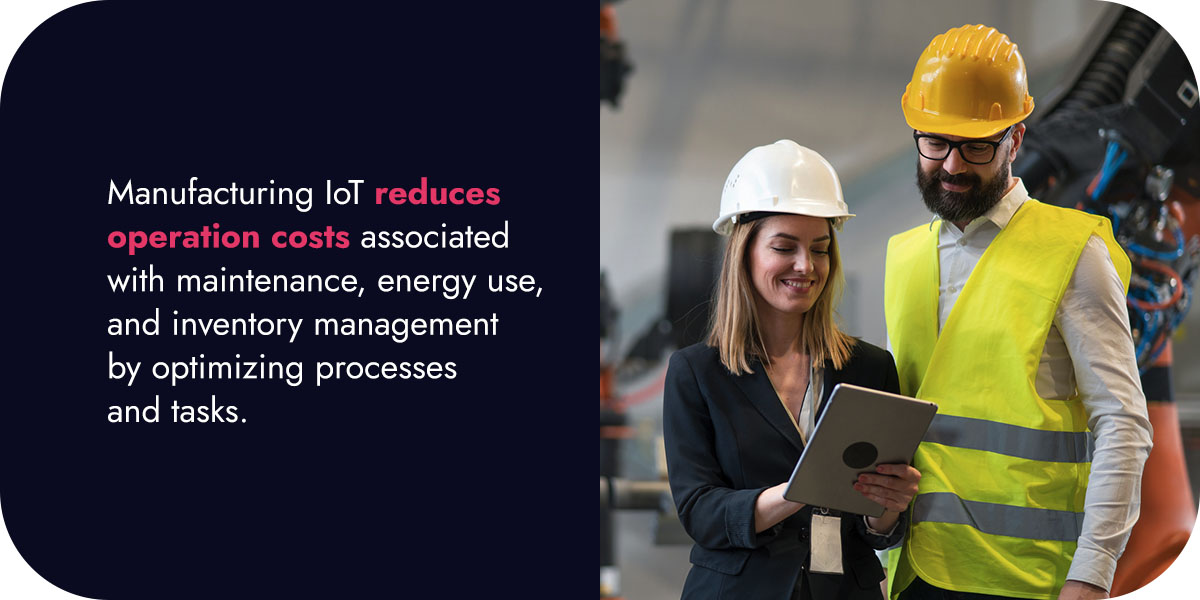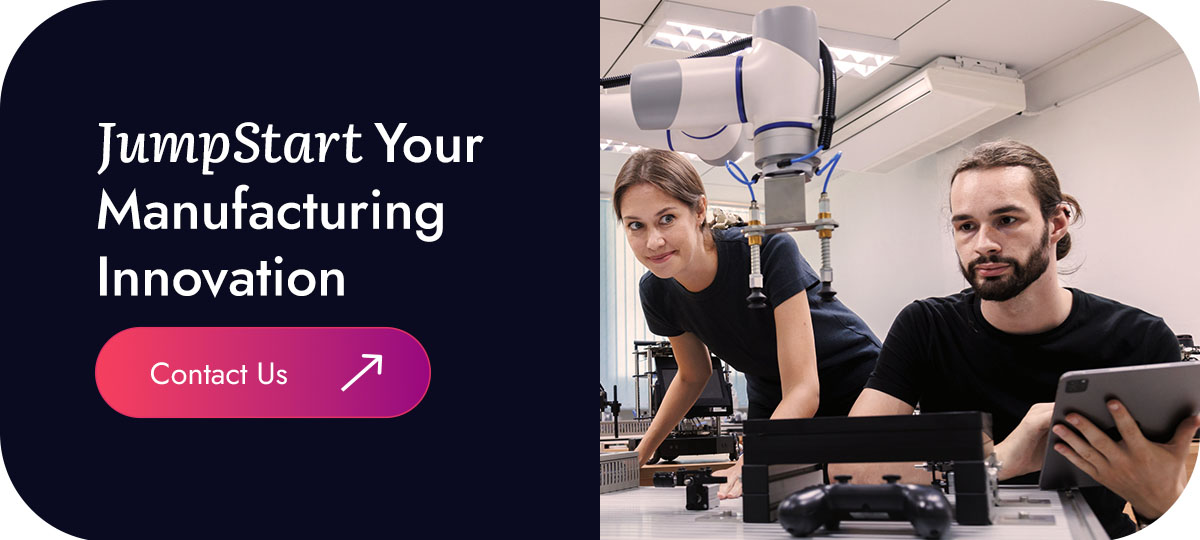
Industrial companies are prioritizing digital technologies to keep pace in a challenging market. The Internet of Things (IoT) is a common foundational technology powering this digital transformation, helping manufacturing companies connect, monitor, analyze, and make informed, data-driven decisions. Industrial IoT solutions enhance efficiency, maximize revenue growth, and reduce costs across your organization.
Explore how IoT technology works, its benefits, and how to leverage it for your manufacturing processes.
Introduction to IoT in Industrial Innovation
IoT is a network of interconnected devices with sensors, software, and connectivity that collect and exchange data. These devices communicate with each other and with centralized systems to perform tasks based on the data they receive.
Elements of IoT include:
- Devices: IoT uses physical objects like actuators, sensors, and other gadgets that are connected to the internet.
- Connectivity: Protocols like Wi-Fi and Bluetooth are critical elements in IoT and manufacturing, as they facilitate communication between devices and central systems.
- Data: IoT devices use the information they collect through sensors to transmit and process it for decision-making.
- Cloud: The cloud provides storage, processing power, and analytics capabilities to handle large and complex volumes of IoT data.
- Applications: These are the software applications that utilize IoT data for monitoring, control, automation, and optimization.
- Security technologies: These include encryption, authentication, and access control mechanisms to share data in a highly controlled and secured way.
There are endless possibilities for the Internet of Things in manufacturing. The digital technology is shaping the industry, allowing for real-time monitoring, predictive maintenance, and data-driven decision-making. Drive growth with IoT by using it to reduce your downtime, increase efficiency, and improve product quality — all critical in a rapidly evolving market.
Benefits of IoT Adoption
IoT optimizes your processes, enhances supply chain visibility, and drives operation excellence. Here are a few benefits of leveraging manufacturing IoT technologies.
Visualize Operations
IoT provides real-time data insights and identifies bottlenecks to make continuous improvements in your warehouse. Consider a warehouse that handles thousands of products for an e-commerce company. By leveraging data from IoT, the warehouse can automatically track the quality of each product and raise an alert or automatically place an order to replenish the stock when needed.
When you leverage IoT, you can measure real-time product output, adjust your production schedules and inventory levels accordingly, and maximize resource utilization. You can also enhance the efficiency of your operations by using IoT-powered predictive analytics to forecast demand patterns.
Easier Maintenance
Use IoT to remotely monitor your equipment’s health and performance. This way, you can come up with predictive maintenance strategies that reduce downtime, extend the life span of your equipment, and enhance its overall effectiveness. By remotely accessing equipment status and performance data in real time, your team detects issues early, schedules maintenance quickly, and prevents costly breakdowns that could impact your production schedule.
Cost Reduction

Manufacturing IoT reduces operation costs associated with maintenance, energy use, and inventory management by optimizing processes and tasks. Additionally, IoT insights into your equipment and energy use patterns allow you to implement energy-saving measures and resource-efficient practices that lead to long-term cost savings and sustainability goals.
Quality Assurance
IoT contributes to quality assurance in many ways. It can monitor your production processes in real time to detect defects early. It can also ensure compliance with quality standards so you deliver products that meet customer expectations for reliability and performance. Ultimately, IoT improves product consistency, reduces defects, and ensures customer satisfaction by delivering high-quality products.
Industrial IoT Applications
The uses for IoT are endless, and many companies have become more efficient because of it. Consider the various IoT applications and use cases.
Optimizing Supply Chains
Industrial Internet of Things solutions include greater supply chain visibility. Get real-time insights into each stage of the supply chain, from raw material sourcing to delivery. The digital technology collects and analyzes data from connected devices, helping you track inventory levels, monitor shipment status, and identify inefficiencies. Use IoT in supply chain operations to process data and gain insights into performance metrics, trends, and opportunities for optimization.
Amazon, Volvo, and Nissan are all examples of companies successfully leveraging IoT to manage and optimize their supply chains for greater efficiency. Volvo uses IoT to track and deliver products worldwide, Nissan uses it to link multiple industrial units, and Amazon uses an IoT event simulator that creates and transmits location telemetry to a centralized system.
Powering Additive Manufacturing
IoT also improves additive manufacturing technologies and processes. Additive manufacturing, commonly known as 3D printing, involves building objects layer by layer with digital 3D models. Compared to traditional manufacturing methods, 3D printers reduce material waste and offer faster prototyping, production, and customization — without needing expensive tools.
IoT enhances additive manufacturing technologies by:
- Enabling real-time monitoring of printers.
- Optimizing machine performance.
- Ensuring quality control through sensors that detect deviations.
- Facilitating predictive maintenance to prevent downtime.
- Streamlining production workflows for increased efficiency.
GE Aviation is successfully leveraging additive manufacturing and IoT technologies to optimize the performance of its jet engines. The company is also improving the efficiency of its jet engine production lines with machine learning. IoT allows them to efficiently and accurately analyze data for aircraft testing, improving aircraft models and performance.
Integrating With Cobots
Collaborative robots, also known as cobots, are being used in manufacturing processes like picking, packing and palletizing products, welding, assembly, material handling, and quality control. When integrated with IoT, cobots can produce goods more quickly and efficiently while reducing costs associated with human labor. Cobots also offer better precision and repeatability, increasing production quality.
Cobots also promote workplace safety. For example, Ford uses cobots to support skilled workers with injuries or illnesses that limit their physical work capacity. Ford developed Robbie the Cobot to work with the assembly line employees to press in and attach covers for the engine block’s variable camshaft timing.
Enhancing the Role of Digital Twins
Digital twins provide a real-time virtual representation of a physical device or asset. Manufacturers might use digital twins to test product customizations and modifications. They can also recreate production lines with bottlenecks and simulate corrections digitally before executing the physical corrections.
Implementing IoT with digital twin capabilities in a factory or machine plant allows better visibility, accurate predictions, documentation, and communication. An example is the multinational aerospace and defense company Rolls-Royce, which uses IoT digital twin technology to monitor its engines, extending the time between maintenance for engines by up to 50%.
JumpStart Your Manufacturing Innovation
Industrial IoT solutions make many processes much more efficient, reducing costs and optimizing supply chains. While it can transform your business for the better, IoT can be challenging to implement without the right resources on your side. Kopius’ JumpStart program helps you successfully integrate manufacturing IoT into your processes and unlock opportunities for innovation.
Our program fast-tracks new manufacturing solutions so that you achieve faster business results. Connect with us today to meet your digital initiatives and gain a competitive edge.
Related Services:
- IoT Development Services
- Digital Product Development
- Cloud Strategy
- Predictive Analytics Solutions
- Data & Analytics Solutions
Additional Resources:
